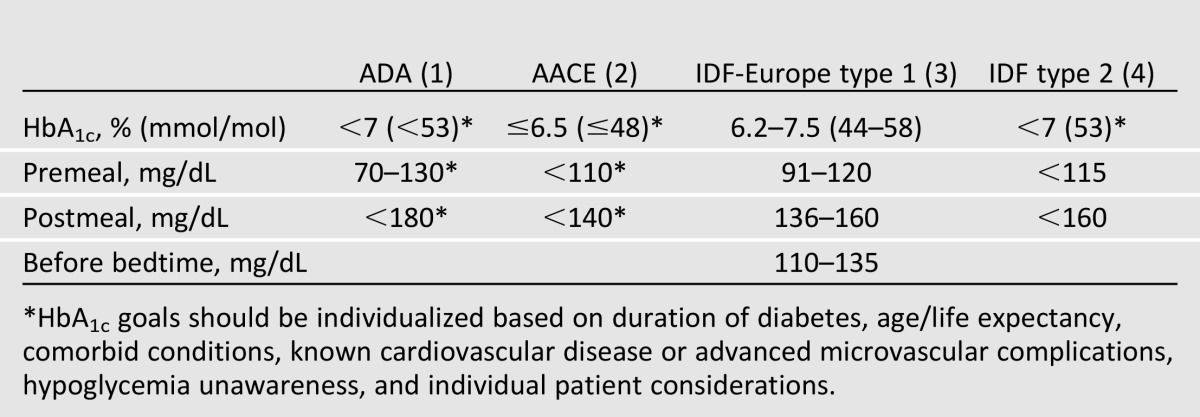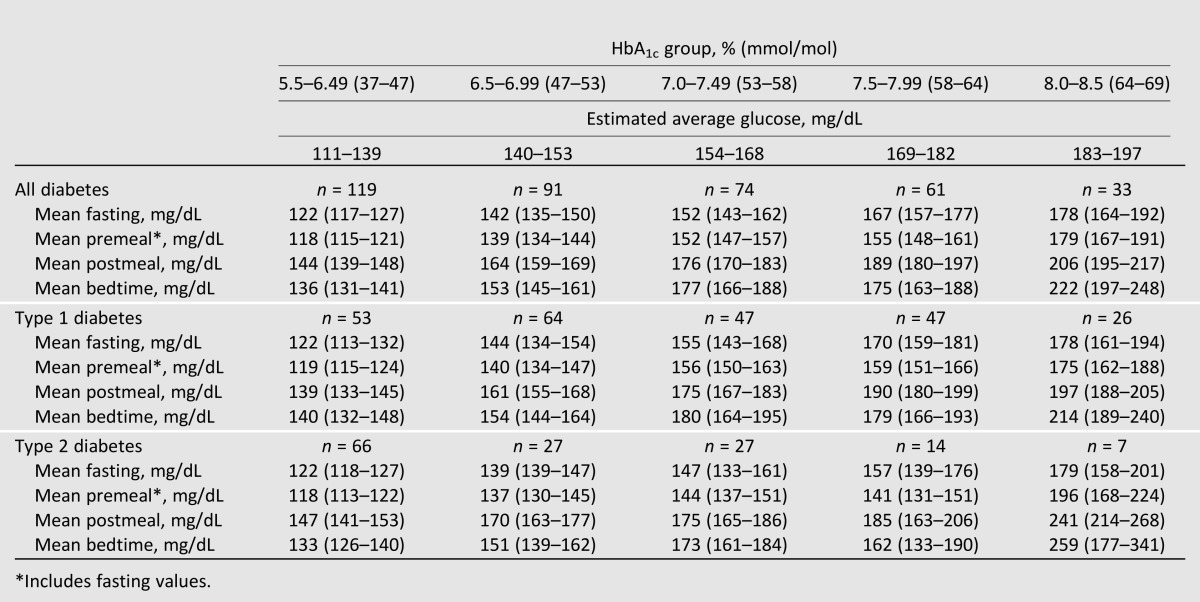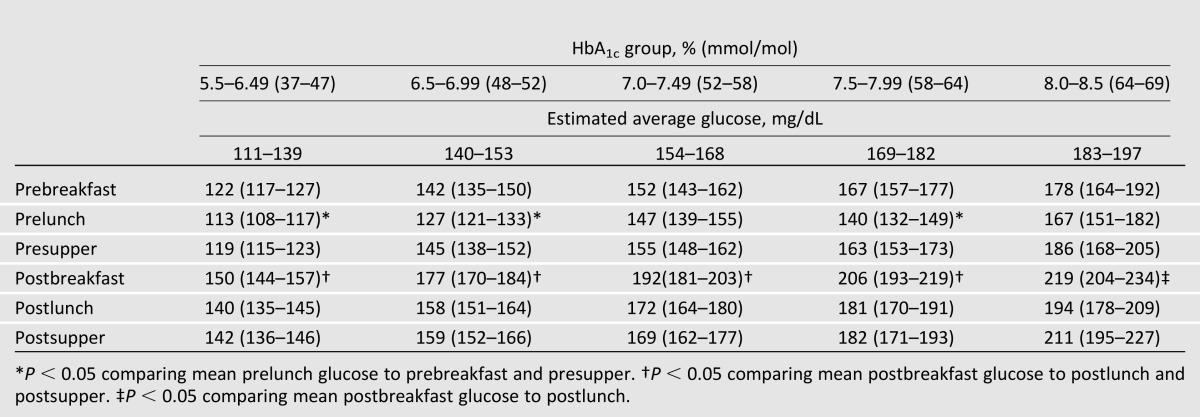Abstract
OBJECTIVE
To determine the average fasting, postprandial, and bedtime self-monitored blood glucose (SMBG) concentrations associated with specified HbA1c levels using data from the A1c-Derived Average Glucose (ADAG) study.
RESEARCH DESIGN AND METHODS
The ADAG study was a multicenter observational study that used continuous glucose monitoring and SMBG testing to determine the relationship between mean average glucose and HbA1c. We used the SMBG data from 470 of the ADAG study participants (237 with type 1 diabetes and 147 with type 2 diabetes) to determine the average fasting, premeal, 90-min postmeal, and bedtime blood glucose (BG) for predefined target HbA1c groups between 5.5 and 8.5% (37–69 mmol/mol). t Tests were used to compare mean BG values between type 1 and type 2 diabetes groups.
RESULTS
The average fasting BG needed to achieve predefined HbA1c target levels of 5.5–6.49% (37–47 mmol/mol), 6.5–6.99% (48–52 mmol/mol), 7.0–7.49% (52–58 mmol/mol), 7.5–7.99% (58–64 mmol/mol), and 8.0–8.5% (64–69 mmol/mol) were 122 mg/dL with 95% CI 117–127, 142 mg/dL (135–150), 152 mg/dL (143–162), 167 mg/dL (157–177), and 178 mg/dL (164–192), respectively. Postmeal BG to achieve the HbA1c level of 6.5–6.99% (48–52 mmol/mol) and 7.0–7.49% (52–58 mmol/mol) were 139 mg/dL (134–144) and 152 mg/dL (147–157), respectively. Bedtime BG was 153 mg/dL (145–161) and 177 mg/dL (166–188), respectively.
CONCLUSIONS
We have determined the average BG at premeal, postmeal, and bedtime to achieve a variety of HbA1c targets. These results, based on empirical data, will help patients and providers set realistic day-to-day SMBG targets to achieve individualized HbA1c goals.
Introduction
Recent diabetes management guidelines specify that treatment goals should be individualized based on age, comorbidities, and duration of disease, with an American Diabetes Association (ADA)/European Association for the Study of Diabetes goal of <7% (<53 mmol/mol) or American Association of Clinical Endocrinologists (AACE) goal of ≤6.5% (≤48 mmol/mol) in otherwise healthy patients (1,2). Although HbA1c is the target, it is measured once every 3 months, and day-to-day self-management of diabetes to achieve and maintain the individualized target HbA1c is facilitated by self-monitored blood glucose (SMBG) values, especially in patients treated with insulin (1–4). To achieve the recommended HbA1c goals, the ADA, the European Association for the Study of Diabetes, the AACE, and the International Diabetes Federation (IDF) have recommend SMBG targets (Table 1), the origins of which are obscure but appear to be based predominantly on expert opinion (1–5). As a result, there is wide variation in the recommended SMBG targets to achieve a HbA1c <7% (<53 mmol/mol) and little to guide clinicians and patients on how to achieve other, individualized, targets.
Table 1.
Summary of current SMBG targets

We sought to determine the average fasting, postprandial, and bedtime glucose values, based on empirical data, to achieve and maintain target HbA1c levels in the outpatient setting.
Research Design and Methods
We analyzed blood glucose (BG) data from the A1c-Derived Average Glucose (ADAG) study, which was conducted to establish the relationship between average glucose concentrations and HbA1c levels (6). The details of the ADAG study have been published previously. In brief, the ADAG study cohort consisted of 507 nonpregnant adult individuals between 18 and 70 years old with stable HbA1c values for 3 months from 10 international centers: U.S. (6), Europe (3), and Africa (1). There were 268 with type 1 diabetes, 159 with type 2 diabetes, and 80 without diabetes. During the 12-week study period, HbA1c was measured monthly, and continuous glucose monitoring (CGM) (Medtronic MiniMed, Northridge, CA) was performed at baseline and three times at 4-week intervals for at least a 48 h period, with glucose levels assessed every 5 min. Participants were asked to perform 8-point SMBG profiles (preprandial, 90-min postprandial, bedtime, and 3:00 a.m.) with a HemoCue Glucose 201+ meter (HemoCue, Angelholm, Sweden) during CGM. All analyzed glucose values were plasma equivalents. Participants measured premeal and postmeal glucose concentrations with a HemoCue device that was regularly calibrated and checked for correct time and date. The prebreakfast HemoCue glucose was considered the fasting value. Premeal glucose levels included any glucose designated before a meal. Glucose levels were not specifically flagged as at bedtime on the HemoCue device, so we chose any unflagged HemoCue value between 8:00 p.m. and 12:00 a.m. as a surrogate for bedtime BG. Although we had access to CGM and LifeScan SMBG data, timing of meals was not indicated for these methods, and therefore they were not used to determine periprandial glucose measurements.
We performed the current analyses on 378 of the originally published cohort (237 type 1 diabetes patients, representing 88% of the original ADAG study cohort, and 141 type 2 diabetes patients, 89% of original cohort). They were selected based on having HbA1c values at 3 months between 5.5 and 8.5% (37–69 mmol/mol). These subjects had a total of 30,108 HemoCue BG values (4,031 fasting, 12,943 before meal, 12,602 90 min after a meal, and 4,563 at bedtime) monitored over an average of 11 days per participant during the 12-week study period. There were, on average, 9 fasting, 28 premeal (including fasting), 27 postmeal, and 7 bedtime HemoCue (SMBG) values for each subject.
We calculated the mean fasting, premeal, postmeal, and bedtime BG for each participant. For each HbA1c group of 5.5–6.49% (37–47 mmol/mol), 6.5–6.99% (48–52 mmol/mol), 7.0–7.49% (52–58 mmol/mol), 7.5–7.99% (58–64 mmol/mol), and 8.0–8.5% (64–69 mmol/mol), the mean fasting, premeal, postmeal, and bedtime BG of the participants within the group were averaged. The mean premeal, postmeal, and bedtime BG were compared between type 1 and type 2 diabetes patients using t tests.
All analyses were performed with SAS version 9.3. The protocol was approved by the Partners Healthcare Institutional Review Board.
Results
Mean fasting, premeal, 90-min postmeal, and bedtime BG in each HbA1c group of 5.5–6.49% (37–47 mmol/mol), 6.5–6.99% (48–52 mmol/mol), 7.0–7.49% (52–58 mmol/mol), 7.5–7.99% (58–64 mmol/mol), and 8.0–8.5% (64–69 mmol/mol) are summarized in Table 2. There was no difference in mean fasting BG between type 1 and type 2 diabetes within the same HbA1c group. Type 1 diabetes patients had higher average premeal BG compared with type 2 diabetes patients in the HbA1c 7.0–7.49% (52–58 mmol/mol) group (BG 156 vs. 144 mg/dL; P = 0.01) and the HbA1c 7.5–7.99% (58–64 mmol/mol) group (BG 159 vs. 141 mg/dL; P = 0.01). Conversely, patients with type 2 diabetes in the highest HbA1c group, 8.0–8.5% (64–69 mmol/mol), had a significantly higher postmeal BG of 241 vs. 197 mg/dL (P = 0.02) compared with the type 1 diabetes patients.
Table 2.
Average glucose levels (95% CI) for specified HbA1c levels

There were significant differences in mean premeal and postmeal BG between specified breakfast, lunch, and supper meals, with the average prelunch BG significantly lower than the prebreakfast and supper averages in patients in the prespecified HbA1c groups (Table 3). The average postbreakfast BG was significantly higher than the postlunch and supper averages across nearly all HbA1c groups analyzed.
Table 3.
Average glucose levels (mg/dL) (95% CI) before and after meals for specified HbA1c levels

Conclusions
Since the Diabetes Control and Complications Trial (DCCT) and UK Prospective Diabetes Study established the importance of glycemic control to ameliorate diabetes-related complications, great effort has been expended to achieve the HbA1c targets that proved effective in those studies. With the publication of the DCCT results in 1993, recommendations for SMBG targets were based largely on the DCCT protocol in which SMBG targets were 70–120 mg/dL preprandial and <180 mg/dL postprandial (7,8). The provenance of the specified target glucose levels is unclear. Currently recommended SMBG targets appear to be largely based on expert opinion or from extrapolations from regression equations comparing the mean of all the daily capillary-measured plasma glucose levels, independent of the distribution during the day, and HbA1c.
We sought to determine the average SMBG values for a range of stable HbA1c targets of 5.5–8.5% (37–69 mmol/mol) and found that the currently published SMBG targets are not consistent with the empirical data. For example, in contrast with the published premeal BG targets (Table 1), where most organizations have recommended premeal/fasting BG <110–115 mg/dL, the results from the ADAG study revealed that patients achieving HbA1c 5.5–6.49% (37–47 mmol/mol) had a mean premeal BG of 122 mg/dL (95% CI 117–127) and those with HbA1c 6.5–6.99% (48–52 mmol/mol) had a mean premeal BG of 142 mg/dL (95% CI 135–150). The postprandial BG levels derived from the ADAG study data were more in-line with the published guidelines; however, where the recommended targets are often “less than 180 mg/dL,” we have been able to quantify the actual values (∼150 mg/dL) that will result in HbA1c levels <7% (<53 mmol/mol). The consequences of using the previously published, nonempirical data may include pushing patients harder to achieve lower fasting levels than are actually required. Considering the safety concerns surrounding hypoglycemia, in particular, nocturnal hypoglycemia and hypoglycemia unawareness, the current recommended glucose targets emphasizing lower fasting BG and higher postprandial BG should be re-evaluated. The target BG levels necessary to achieve specified HbA1c values were generally similar for type 1 and type 2 diabetes patients (Table 2), endorsing a similar set of target values regardless of type of diabetes in nonpregnant adults. While there were statistically significant differences between prelunch and postbreakfast BG averages compared with other meals within an HbA1c group, clinically these differences are small (<15% difference within an HbA1c group), and it would be reasonable to apply the aggregate premeal and aggregate postmeal BG values for all meals.
A strength of the ADAG study in addressing BG targets is that it included people with a wide range of stable HbA1c values from many different communities. Although the BG measurements over the course of the 12-week study were measured in a structured way (before meals and 2 h after meals), the timing of measurements was dictated by the participants real-life environment and schedule. Both a strength and a limitation of this study is that the BG measurements were obtained with a laboratory-quality point-of-care glucose monitoring device, which may give somewhat more precise and accurate BG measurements than usual consumer SMBG devices, something that will need to be accounted for when extrapolating these results to clinical practice. The relatively small numbers of type 2 diabetes patients, especially at the higher HbA1c ranges, resulted in larger CIs for this subgroup, but with the exception of postprandial mean BG in the highest HbA1c target range of 8.0–8.5%, the mean values between type 1 and type 2 diabetes patients were similar (<15% difference within an HbA1c group), and we chose to present the aggregate data. Another potential limitation is that we did not account for differences in treatment regimens, but our focus was on determining the achieved mean BG for a given stable HbA1c regardless of treatment regimen.
The choice of glucose monitoring schedule and goals remains complex, predicated on target HbA1c, treatment regimens, risk of hypoglycemia, and cost-effectiveness. For patients and providers, setting appropriate day-to-day BG testing goals to achieve a specific and individualized HbA1c target is important to guide the patient’s self-care and self-management. The current study establishes realistic target BG levels, based on empirical data, to inform our patient-centered care. We hope that these data will be used by professional societies, clinicians, and patients to guide the appropriate choice of glucose targets and treatment to achieve their individualized HbA1c goal.
Article Information
Acknowledgments. The data utilized in this study were generated during the A1c\x{2010}Derived Average Glucose (ADAG) study and the authors are grateful to the investigators in that multicenter study.
Funding. N.W. was supported by a National Institute of Diabetes and Digestive and Kidney Diseases training grant (T32 DK-007-028). D.M.N. is supported in part by the Charlton Fund for Innovative Research in Diabetes.
Duality of Interest. No potential conflicts of interest relevant to this article were reported.
Author Contributions. N.W. contributed to the hypothesis, study design, and data analysis and wrote the manuscript. H.Z. contributed to the study design and data analysis. D.M.N. contributed to the hypothesis, data collection, study design, and discussion and reviewed the manuscript. N.W. is the guarantor of this work and, as such, had full access to all the data in the study and takes responsibility for the integrity of the data and the accuracy of the data analysis.
References
- 1.American Diabetes Association Standards of medical care in diabetes—2013. Diabetes Care 2013;36(Suppl. 1):S11–S66 [DOI] [PMC free article] [PubMed] [Google Scholar]
- 2.Handelsman Y, Mechanick JI, Blonde L, et al. AACE Task Force for Developing Diabetes Comprehensive Care Plan American Association of Clinical Endocrinologists Medical Guidelines for Clinical Practice for developing a diabetes mellitus comprehensive care plan. Endocr Pract 2011;17(Suppl. 2):1–53 [DOI] [PubMed] [Google Scholar]
- 3.International Diabetes Federation (European Region). A Desktop Guide to Type 1 (Insulin-Dependent Diabetes) [Internet], 1998. Available from http://www.staff.ncl.ac.uk/philip.home/t1dg1998.htm Accessed 20 December 2013
- 4.IDF Clinical Guidelines Task Force. Global guideline for type 2 diabetes. Brussels, International Diabetes Federation [Internet], 2012. Available from http://www.idf.org Accessed 20 December 2013
- 5.Rydén L, Standl E, Bartnik M, et al. Task Force on Diabetes and Cardiovascular Diseases of the European Society of Cardiology (ESC) European Association for the Study of Diabetes (EASD) Guidelines on diabetes, pre-diabetes, and cardiovascular diseases: executive summary. Eur Heart J 2007;28:88–136 [DOI] [PubMed] [Google Scholar]
- 6.Nathan DM, Kuenen J, Borg R, Zheng H, Schoenfeld D, Heine RJ, A1C-Derived Average Glucose Study Group Translating the A1C assay into estimated average glucose values. Diabetes Care 2008;31:1473–1478 [DOI] [PMC free article] [PubMed] [Google Scholar]
- 7.Weir GC, Nathan DM, Singer DE. Standards of care for diabetes. Diabetes Care 1994;17:1514–1522 [DOI] [PubMed] [Google Scholar]
- 8.Nathan DM. Long-term complications of diabetes mellitus. N Engl J Med 1993;328:1676–1685 [DOI] [PubMed] [Google Scholar]


